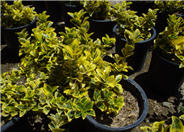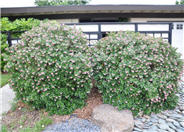
Common name:Midnight Penstemon (dark purple)
Botanical name:Penstemon 'Midnight'
This bushy, perennial shrub is 2'-4' tall with tall, deep violet or blue flower spikes that bloom in spring through fall. Leaves are dark green, lance-shaped and evergreen. Plant in full sun in coastal areas but give afternoon shade in warm inland areas. This plant is a show stopper but short lived, lasting 3-5 years. Well worth the effort to plant!

Common name:White Lily of the Nile
Botanical name:Agapanthus 'White'
This cultivar of Agapanthus africanus is the same as the Lily of the Nile except it blooms white flowers, not blue. It will grow in all soils but prefers loam soil.

Common name:Japanese Boxwood
Botanical name:Buxus microphylla japonica
Japanese Boxwood is often used as a hedge. It is compact, with small bright green leaves. It can reach 4-6' tall and wide or be kept smaller through pruninig. It can be sheared to shape. It does better in areas with milder winters. It prefers full sun and a moderate amount of water.

Common name:Pincushion Flower
Botanical name:Scabiosa caucasica
This perennial will grow 1.5'-2.5' tall and 1'-2' wide. It has medium-size green leaves with lavender-blue flowers that bloom in summer.

Common name:Waxleaf Privet
Botanical name:Ligustrum japonicum 'Texanum'
This dense, evergreen shrub reaches 6'-8' tall and 4'-6' wide. Waxleaf Privet has dark green, leathery, evergreen leaves that make a great privacy hedge. White fragrant flowers bloom in spring and summer. Bees love these flowers! Blue black berries follow bloom season. Part of this shrub may be poisonous if ingested. It prefers full sun to light shade with a medium amount of watering, more in hot summer months.

Common name:Chanticleer Callery Pear
Botanical name:Pyrus calleryana 'Chanticleer'
This dependable tree quickly reaches 25'-40' high and 15' wide. It has an upright pyramidal form. Oval, glossy green leaves turn reddish bronze in fall. White flowers bloom in spring, densely covering the tree. 'Chanticleer' shows changes in the 4 seasons. It is drought tolerant once it's established. It's a great urban tree as it tolerates air pollution.

Common name:Gold Spot Euonymus
Botanical name:Euonymus japonica 'Aureo Variegatus'
Growing to about 8' tall, this evergreen shrub has green foliage with yellow splashes of color. Leaves are glossy and roundish. Flowers are insignificant. It prefers full sun and a location with air circulation to prevent powdery mildew.

Common name:Frades Compact Escallonia
Botanical name:Escallonia 'Frades'
The 'Fradesii' is an evergreen shrub that grows to 6'-8' tall and wide. It is valued for its glossy foliage and clusters of pink flowers. The heaviest bloom period is spring through fall, with some flowers all year. The Escallonias grow best in sun to part shade. It prefers regular watering and more during the summer. Prune in spring to keep it tidy. It makes a great privacy hedge.

Common name:Tree Roses
Botanical name:Rosa Tree varieties
Tree roses are actually shrubs that have been grafted or grown in a way that looks like a tree, ie with a trunk. Tree roses can be floribundas, hybrid teas, or grandifloras. They are typically used as specimen plants. Make sure the plant is tied to a stake in case of strong winds. They reach 3'-6' tall.
| Designer: Mariette Olsen | English Cottage Look |
Photographer: GardenSoft |
Soils and Compost:
Maintain a two to four inch layer of mulch on the soil surface to reduce weeds, infiltrate rain water, and reduce compaction.
Water Saving Tip:
Fix leaking sprinklers, valves, and pipes.
One broken spray sprinkler can waste 10 gallons per minute - or 100 gallons in a typical 10 minute watering cycle.
Integrated Pest Management:
Attract, or buy beneficial insects such as ladybugs and lacewings to control pest outbreaks in your garden.
